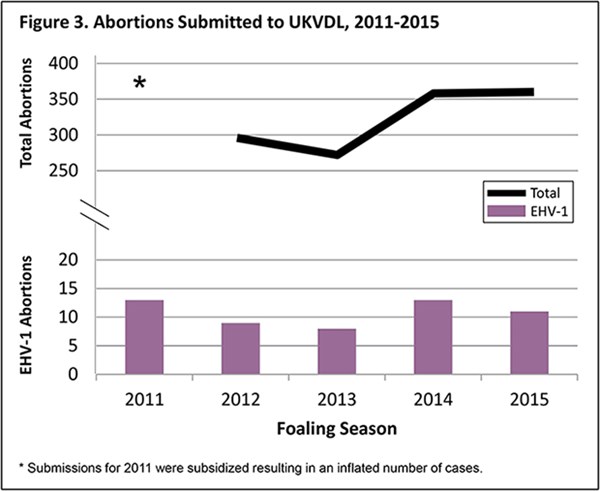 Credit: Thinkstock
Credit: ThinkstockEquine herpesvirus type 1 (EHV-1) is one of five herpesviruses commonly found in horses. EHV-1 infections manifest in three syndromes: respiratory, reproductive and neurologic. Like other herpesviruses, EHV-1 can establish latent infections, making it possible for outbreaks of disease to occur in herds that are considered closed. While quarantine of new arrivals, segregation of young stock, breeding stock and show stock, and vaccination are important management tools in the prevention of EHV-1 infections, complete protection is not possible to achieve. Vaccination confirms relatively short-term immunity (4-5 months) and immunity is not entirely protective, meaning that even well-vaccinated horses can develop disease.
The respiratory form of EHV-1 is generally mild and self-limiting. Clinical signs are indistinguishable from other viral causes of respiratory disease, such as equine influenza and EHV-4. Horses exhibit a fever, cough, serous nasal discharge and mild lethargy.
Reproductive disease is generally considered to be the most economically important manifestation of EHV-1.
Infection with EHV-1 causes abortion in the last trimester of gestation. Affected foals are occasionally born alive, but they are generally very weak and succumb within days of birth, often with secondary disease conditions. The virus infects the mare through the respiratory tract and then enters the bloodstream (viremia), traveling to and infecting the fetus. Infection in the mare is generally inapparent and abortion occurs without any signs of impending parturition. The fetus is aborted fresh, in contrast to other causes of abortion such as leptospirosis, where the fetus may be significantly decomposed.
Following any abortion, the mare should be isolated, fetal tissues should be contained and submitted to a diagnostic laboratory, and in-contact mares should not be moved nor should new mares be brought in until a diagnosis has been rendered. Fetal tissues and uterine fluids should be considered infectious, and contaminated areas should be cleaned with detergent and disinfected. Contaminated bedding should be bagged and discarded and not spread on pastures.
In the case of EHV-1 abortions, the fetal tissues and fluids contain high concentrations of virus; infected foals and mares also shed virus via the respiratory route. EHV-1 is transmitted via the respiratory route and fomites. However, since it is an enveloped virus, herpesvirus is readily inactivated by thorough cleaning with detergents followed by disinfectants. Biosecurity and restricted movement of horses are important in containing EHV-1 infections.
Laboratory diagnosis relies on gross and histologic examination in conjunction with laboratory testing. Gross lesions can include pleural and peritoneal effusion, over-expanded lungs with rib impressions and small white foci scattered throughout the liver. However, there are many cases in which lesions are not identified at necropsy. Histologically, EHV-1 produces necrotizing lesions in a number of organs, most notably the lung and liver. Characteristic intranuclear inclusion bodies are frequent. Common ancillary tests for detection of the virus include fluorescent antibody testing, virus isolation and polymerase chain reaction testing.
EHV-1 abortions can occur singly or may spread rapidly in a susceptible population, leading to the classic “abortion storm.” With improved management and readily available vaccines for EHV-1, the number of cases of EHV-1 abortion has declined dramatically over the past 30 years, with the vast majority of cases being single events. EHV-1 confirmed abortions diagnosed at the University of Kentucky Veterinary Diagnostic Laboratory are shown in the attached figure. During that same time, EHV-1 neonatal deaths were diagnosed in 2011 (one), 2012 (two), and 2014 (one).

Respiratory and reproductive manifestations of EHV-1 are well-documented and have long been recognized. While viral latency and the production of a vaccine that produces long-term immunity and confirms better protection continue to be studied, these syndromes are well understood.
A manifestation of EHV-1 that is less understood is equine herpesvirus myeloencephalopathy (EHM). EHM is a neurologic disease that manifests with acute onset ataxia or paresis, often accompanied by weakness, urinary incontinence, poor tail and anal tone, and tail elevation, either singly or in combination. EHM can occur as a sporadic case of neurologic disease, but often manifests as an outbreak within a single population of horses. Outbreaks are often identified in dense populations of horses, such as at racetracks, horse shows or show barns, riding stables, etc. Generally, these horses are well-vaccinated and vaccination seems to be neither protective nor a risk factor. While the pathology of EHM is well-understood, the production and development of disease is not and is the subject of continued research. Prevention of outbreaks of EHM relies on close observation of the horses, including monitoring of rectal temperatures, swift isolation of affected horses, and often quarantine of the premises.
A constant presence in the horse world, EHV-1 is well known, but many challenges remain.
This article was written by Dr. Laura Kennedy of the University of Kentucky Veterinary Diagnostic Laboratory. It was first published in the Equine Disease Quarterly, which is put out by the University of Kentucky College of Agriculture, Food and Environment Department of Veterinary Science and is sponsored by Lloyd’s of London and its Kentucky agents. You may subscribe to this publication for free.


